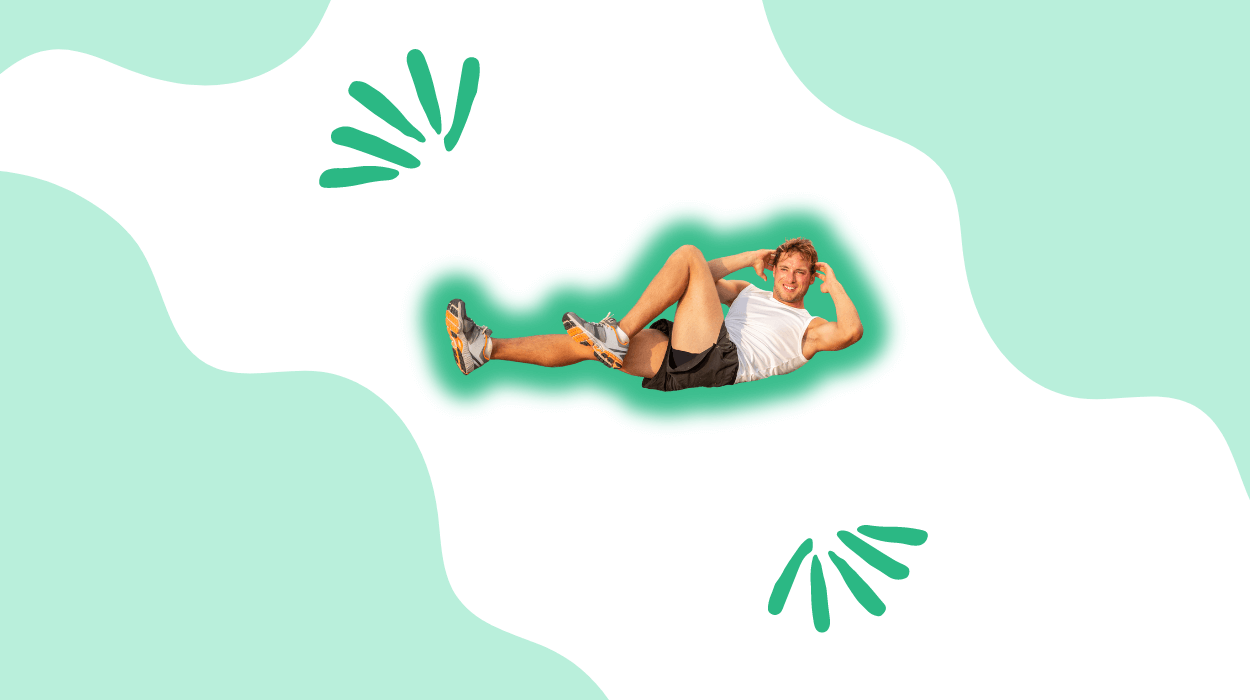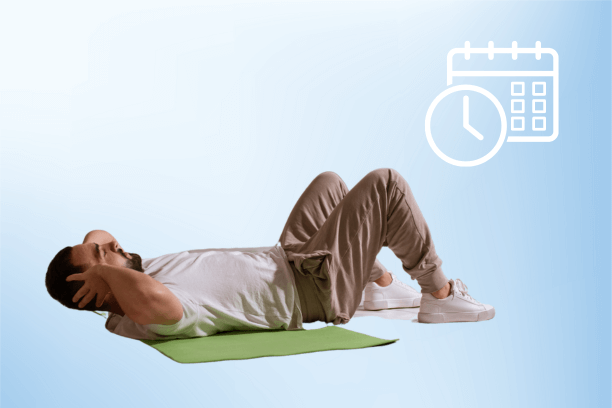

The Sit-up is a classic core exercise that could be performed to reduce belly fat and achieve toned abs. It may not help eliminate fat alone but could contribute to the overall goal of shedding weight and toning the abdominal muscles.
However, you may add sit-ups to a complete workout regimen to obtain toned abdominal muscles and achieve the desired outcomes.
Sit-ups could make your core stronger, and only with a lower body fat percentage could you notice abdominal muscles.
Read this article thoroughly to know how to perform sit-ups and how they could support your weight loss efforts.
As a beginner, you could start performing sit-ups with minimum sets according to your needs. Starting slow may help you perform a challenging workout while avoiding overexertion.
Start with 10-12 reps and perform 2 to e sets of sit-ups. Increase this intensity once your strength and flexibility improve.
Stay consistent with your sit-up routine for effective belly fat reduction and overall fitness. Include sit-ups into your workout routine at least three times a week and gradually increase the intensity as you become stronger.

Strengthening your core through exercises like sit-ups could positively impact your overall posture and musculoskeletal health. They are an effective way to develop core muscles, crucial in supporting proper posture and minimizing strain on muscles and joints.
Sit-ups could be an effective exercise for strengthening muscles in the hip and abdominal areas of the body. It may help build muscle mass, indicating overall physical capability and strength.
The hip muscles, combining the hip flexors and the glutes, could stabilize the pelvis and support lower body movements to help enhance overall stability and mobility.
Sit-ups may provide core stability, posture, and support to the spine by strengthening your muscles. It may alleviate back-neck discomfort and reduce strain on muscles and joints.
Combining sit-ups into your routine might help alleviate stiffness in the body. It could target multiple muscle groups by engaging the abs, hips, lower back, and pelvis, promoting flexibility and reducing discomfort.
Sit-ups involve dynamic movement, which may increase blood flow to the muscles to loosen tight muscles and joints, enhancing flexibility and mobility.
The wide range of motion while performing sit-ups may allow for greater flexibility and improved performance in activities that require bending, twisting, or reaching.
Sit-ups may boost energy levels and also help in enhancing athletic performance and stamina. It may help develop a strong core that improves muscle strength and endurance.
Sit-ups could specifically target the abdominal muscles, including the rectus abdominis, transverse abdominis, internal and external obliques. It could also transfer power and force between the upper and lower body, allowing athletes to generate more explosive movements.
Strengthening core muscles through sit-ups could help decrease the risk of experiencing pain in the back, pelvis, or hips, especially with age.
Sit-ups could strengthen your muscles to provide better support and stability, decreasing the risk of strain and pain. Regular sit-ups can alleviate back and neck discomfort by reducing muscle and joint strain. However, you may avoid performing sit-ups if you have chronic pain and discomfort in your back or other body parts.
Sit-ups may improve the stability of core muscles by placing pressure on the abdomen, which potentially helps boost diaphragm function. A strong diaphragm can strengthen your breathing, enhance athletic performance, and relieve stress.
Use an appropriate exercise mat to ensure proper form and prevent injuries. A mat provides cushioning and support, allowing for a comfortable and stable surface to perform sit-ups.
It is essential to place the exercise mat on a level surface to maintain stability during sit-ups. Uneven surfaces can affect balance and compromise the efficacy of the exercise.
You can also include a stability ball in your sit-ups to bring variety. It may engage additional muscles and challenge balance, enhancing the effectiveness of sit-ups.
Including resistance bands in sit-ups can increase the exercise’s intensity and target different muscle groups. They may provide resistance throughout the movement, helping to strengthen and tone the abdominal muscles more effectively.
You should perform sit-ups in an ideal position, which involves lying flat on your back, as it allows proper form and effective engagement of the abdominal muscles.
While doing sit-ups, gently lift your upper body towards your thighs while keeping both feet planted on the ground to engage your abdominal muscles effectively.
Once you have completed the sit-up, slowly lower yourself back down to the floor and try to repeat the motion while fully engaging your abdominal muscles and maximizing the effectiveness of the exercise.
To maximize your sit-up results, you may consume a diet that contains whole foods such as proteins, fruits, vegetables, and whole grains. These foods could provide essential nutrients while keeping you full and satisfied for longer hours. You can also opt for fiber-rich foods, which help control overall calorie intake.
It is necessary to minimize the consumption of sugary snacks and refined foods that contain excessive fats or calories, as these might interfere with your fat loss efforts.
However, if you want sustainable weight loss, stay within a calorie deficit, burning more calories than you consume.
Sit-ups are effective for strengthening the abdominal muscles, but alternative workouts might help you lose belly fat and achieve a toned waistline.
These alternative workouts could help in losing belly fat. Remember that consistency, gradual progression, and an active lifestyle are crucial to losing belly fat effectively.
No. Sit-ups may strengthen your core muscles but do not solely contribute to losing belly fat. However, a balanced diet, aerobic or resistance exercises, and lifestyle choices may help reduce belly fat.
Sit-up results may vary depending on personal factors such as diet, overall fitness level, and consistency. However, sit-ups may show results within a few months when a consistent and active lifestyle is followed.
Sit-ups could reduce love handles or side belly fat by strengthening core muscles and burning calories. However, spot reduction is not scientifically proven, so combining sit-ups with a balanced diet is crucial for optimal results.
No. Avoiding exercise immediately after a meal is suggested to prevent discomfort and promote digestion. Waiting at least 1-2 hours after a meal before performing sit-ups is advisable.
Sit-ups could enhance the strength of your core muscles. However, depending solely on sit-ups for weight loss or belly fat reduction may not show noticeable results.
You can also consider other exercises such as plank, aerobics, or more to target different body muscles for better body composition and posture.
However, to achieve your weight loss goals and optimal results, combining these exercises with a balanced diet rich in whole foods and containing no processed or added sugars is recommended.
Getting proper sleep, avoiding binge eating, and leading an active lifestyle will help you burn fat to achieve a toned and slim physique.
Tyler Read earned an undergraduate academic degree from Sonoma State University, California and is a certified personal trainer (CPT) with NASM (National Academy of Sports Medicine). With over 16 years of experience, Tyler has trained clients both online and in-person.
He is passionate about helping others turn their love for fitness into a career. Tyler has worked with many local and commercial gyms before establishing his successful private personal training business, which he continues to operate.
